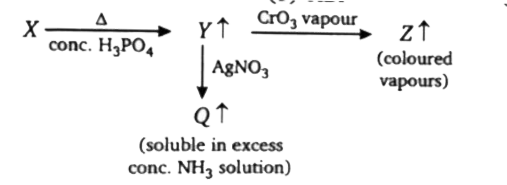What of the following anions are present in clay ?
Al2O3
CO
CO2
CaO
The correct Answer is:C
To determine which anions are present in clay, we can follow these steps:
Step 1: Understand the Composition of Clay
Clay is primarily composed of silicate minerals, which typically include various anions. The most common anions found in clay minerals are silicate (SiO4^4−) and aluminum (AlO2^−).
Step 2: Analyze the Given Options
The question provides several options for anions. We need to evaluate each option to see if it is commonly found in clay.
Step 3: Identify the Relevant Anions
- Silicate (SiO4^4−): A major component of clay.
- Aluminate (AlO2^−): Also commonly found in clay.
- Carbonate (CO3^2−): While not a primary component, it can be present in some clays.
- Sulfate (SO4^2−): Generally not a major component of clay.
Step 4: Conclusion
Based on the analysis, the most relevant anions present in clay are silicate and aluminate. If the options included these, they would be the correct answers. However, if CO2 was mentioned in the context of anions, it is important to clarify that CO2 itself is not an anion but can form carbonate ions in solution.
Final Answer
The correct anion that is commonly associated with clay is silicate (SiO4^4−), and if carbonate (CO3^2−) was an option, it could also be considered.
---
Clay is primarily composed of silicate minerals, which typically include various anions. The most common anions found in clay minerals are silicate (SiO4^4−) and aluminum (AlO2^−).
The question provides several options for anions. We need to evaluate each option to see if it is commonly found in clay.
- Silicate (SiO4^4−): A major component of clay.
- Aluminate (AlO2^−): Also commonly found in clay.
- Carbonate (CO3^2−): While not a primary component, it can be present in some clays.
- Sulfate (SO4^2−): Generally not a major component of clay.
Based on the analysis, the most relevant anions present in clay are silicate and aluminate. If the options included these, they would be the correct answers. However, if CO2 was mentioned in the context of anions, it is important to clarify that CO2 itself is not an anion but can form carbonate ions in solution.
The correct anion that is commonly associated with clay is silicate (SiO4^4−), and if carbonate (CO3^2−) was an option, it could also be considered.
Topper's Solved these Questions
- P-BLOCK GROUP 14 - CARBON FAMILYBOOK - CENGAGE CHEMISTRY ENGLISHCHAPTER - P-BLOCK GROUP 14 - CARBON FAMILYEXERCISE - Exercises (Assertion-Reasoning)
27 Videos
- P-BLOCK GROUP 14 - CARBON FAMILYBOOK - CENGAGE CHEMISTRY ENGLISHCHAPTER - P-BLOCK GROUP 14 - CARBON FAMILYEXERCISE - Exercises (Integer)
7 Videos
- P-BLOCK GROUP 14 - CARBON FAMILYBOOK - CENGAGE CHEMISTRY ENGLISHCHAPTER - P-BLOCK GROUP 14 - CARBON FAMILYEXERCISE - Exercises (Multiple Correct )
19 Videos
- P-BLOCK GROUP 13 - BORON FAMILYBOOK - CENGAGE CHEMISTRY ENGLISHCHAPTER - P-BLOCK GROUP 13 - BORON FAMILYEXERCISE - Exercise Archives (Subjecive)
9 Videos
- PERIODIC CLASSIFICATION OF ELEMENTS AND GENERAL INORGANIC CHEMISTRYBOOK - CENGAGE CHEMISTRY ENGLISHCHAPTER - PERIODIC CLASSIFICATION OF ELEMENTS AND GENERAL INORGANIC CHEMISTRYEXERCISE - Exercises (Archives )Subjective
4 Videos
Similar Questions
Knowledge Check
Which of the following anions are more stable than benzyl anion ?
A B
B C
C D
D
Which of the following anions is resonance destabilized?
A B
B C
C D
D
Sodium salt solution +AgNO3soln.→Coloured precipitate.
If coloured precipitate is soluble in both dil. HNO3 and excess conc. NH3 solution then which of the following anion is present in the salt solution?
View SolutionWhich of the following anions are identified by dil. HCl :
View Solution
Which of the following anion cannot be in X?
View Solution
Which of the following anion cannot be in X?
View SolutionWhich of the following anion(s) is/are interfering radicate ?
View SolutionWhich of the following anions is the weakest base ?
View Solution
